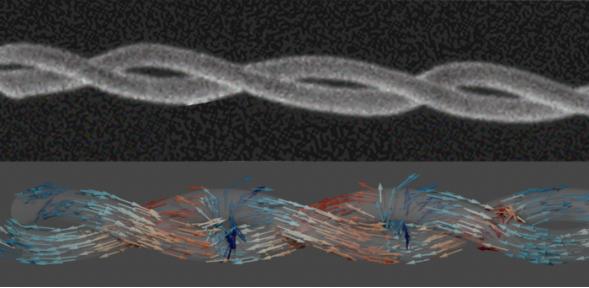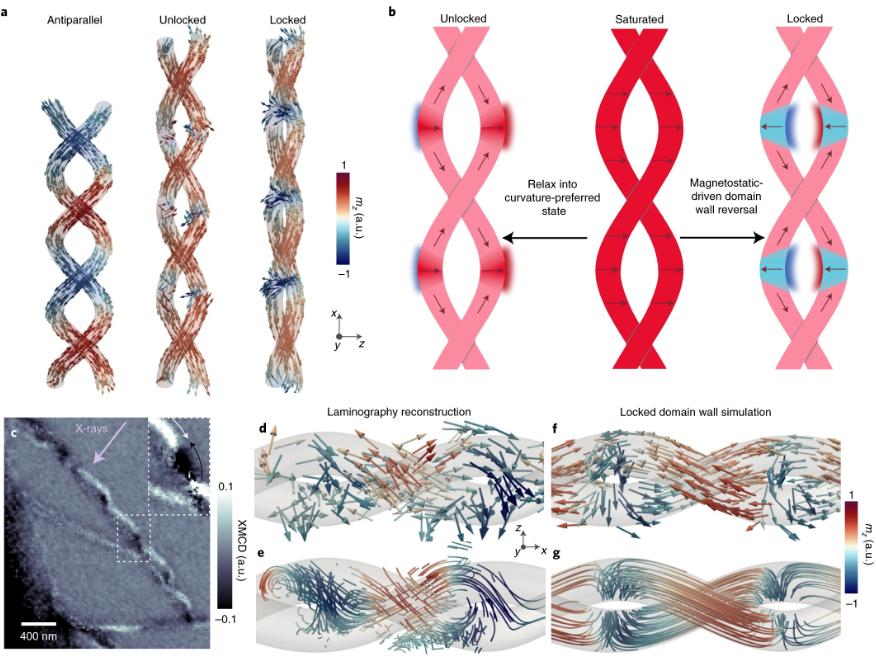博文
3D打印纳米磁铁揭开了磁场中图案的世界
 精选
精选
||
3D打印纳米磁铁揭开了磁场中图案的世界
诸平


Fig. 1: Ferromagnetic double helices.

Fig. 2: The ‘locked’ domain wall state.
据英国剑桥大学(University of Cambridge)2021年12月20日报道,科学家们利用最先进的3D打印技术和显微镜技术,让人们对在比人类头发还要细1000倍的纳米尺度上使用三维磁铁会发生什么有了新的认识(3D printed nanomagnets unveil a world of patterns in the magnetic field)。
由剑桥大学卡文迪什实验室(Cambridge University's Cavendish Laboratory)领导的国际团队,使用了他们开发的先进3D打印技术来创造磁性双螺旋(magnetic double helices),就像DNA的双螺旋一样,它们相互缠绕,结合了曲率、手性和双螺旋之间的强磁场相互作用。在这样做的过程中,科学家们发现这些磁性双螺旋在磁场中产生了纳米级的拓扑纹理,这是以前从未见过的,为下一代磁性设备打开了大门。相关研究结果于2021年12月20日已经在《自然纳米技术》(Nature Nanotechnology)杂志网站发表——Claire Donnelly, Aurelio Hierro-Rodríguez, Claas Abert, Katharina Witte, Luka Skoric, Dédalo Sanz-Hernández, Simone Finizio, Fanfan Meng, Stephen McVitie, Jörg Raabe, Dieter Suess, Russell Cowburn, Amalio Fernández-Pacheco. Complex free-space magnetic field textures induced by three-dimensional magnetic nanostructures. Nature Nanotechnology, Published: 20 December 2021. DOI:10.1038/s41565-021-01027-7. http://www.nature.com/articles/s41565-021-01027-7
参与此项研究的除了剑桥大学的研究人员之外,还有来自英国格拉斯哥大学(University of Glasgow);德国马克斯·普朗克固体化学物理研究所(Max Planck Institute for Chemical Physics of Solids)、西班牙奥维耶多大学(Universidad de Oviedo, Oviedo, Spain)、CSIC-奥维耶多大学CINN (CINN, CSIC–Universidad de Oviedo)、奥地利维也纳大学(University of Vienna)以及瑞士保罗谢勒研究所(Paul Scherrer Institute, Villigen, Switzerland)的研究人员。
磁性设备影响着我们社会的许多不同部分,磁铁被用于能源的产生,数据存储和计算。但在二维系统中,磁性计算设备正迅速接近其收缩极限。对于下一代的计算,有越来越多的兴趣移动到三维,在那里不仅可以实现更高的密度与三维纳米线结构,而且三维几何可以改变磁性(magnetic properties)和提供新的功能。
这项研究的第一作者、剑桥大学卡文迪什实验室的克莱尔·唐纳利(Claire Donnelly)说:“围绕一种被称为赛道记忆(racetrack memory)的尚未建立的技术进行了大量的工作,这项技术是由斯图尔特·帕金(Stuart Parkin)首先提出的。其想法是将数字数据存储在纳米线的磁畴壁上,从而生产出具有高可靠性、高性能和高容量的信息存储设备。”克莱尔·唐纳利是最近刚搬到了德国马克斯·普朗克固体化学物理研究所的。
“但到目前为止,这个想法一直很难实现,因为我们需要能够制造三维磁场系统,我们还需要了解三维磁场对磁化和磁场的影响。”
“所以,在过去的几年里,我们的研究专注于开发新的方法来可视化三维磁结构,就像医院里的CT扫描一样,但扫描的对象磁体而不是人体。我们还开发了磁性材料(magnetic materials)的3D打印技术。”
3D测量是在保罗谢勒研究所的瑞士光源的波利克斯光束线(PolLux beamline of the Swiss Light Source at the Paul Scherrer Institute)上进行的,这是目前唯一能够提供软X射线分层压成像(soft X-ray laminography)的光束线。利用这些先进的X射线成像技术,研究人员观察到,与2D图像相比,3D DNA结构在磁化时产生了不同的纹理。相邻螺旋中的磁畴(磁化所有指向同一方向的区域)之间的磁畴壁对是高度耦合的,因此会变形。这些磁畴壁相互吸引,由于其3D结构,它们会旋转、“锁定”到合适的位置,并形成牢固、规则的键,类似于DNA中的碱基对。
克莱尔·唐纳利说:“我们不仅发现,在磁化过程中,3D结构导致了有趣的拓扑纳米纹理,这是我们相对习惯看到的纹理,而且在磁杂散场(magnetic stray field)中,揭示了令人兴奋的新的纳米级磁场配置!”
“这种在这个长度尺度上绘制磁场图案的新能力,允许我们定义将会对磁性材料施加什么力,并理解我们可以在多大程度上绘制这些磁场图案。如果我们能在纳米尺度上控制这些磁力,我们就能更接近于在二维尺度上的控制程度。”
该研究的通讯作者阿马利奥·费尔南德斯-帕切科(Amalio Fernandez-Pacheco)解释说:“这一结果令人着迷——DNA样双螺旋结构在螺旋之间形成了强键,从而改变了它们的形状。但更令人兴奋的是,这些键周围形成了磁场拓扑纹理(topological textures)的漩涡。”费尔南德斯-帕切科曾是卡文迪什实验室的研究员,现在在阿拉贡纳米科学与材料研究所(Institute of Nanoscience & Materials of Aragón)工作。
从磁化的角度来看,从二维到三维,现在克莱尔·唐纳利和她来自保罗谢勒研究所和格拉斯哥大学、萨拉戈萨大学、奥维耶多大学和维也纳大学(Universities of Glasgow, Zaragoza, Oviedo, and Vienna)的合作者将探索从二维到三维磁场的全部潜力。
阿马利奥·费尔南德斯-帕切科说:“这项工作的前景是多方面的:磁螺旋中的这些强结合纹理预示了高度健壮的运动,并可能是一个潜在的信息载体。更令人兴奋的是这种在纳米尺度上构建磁场模式的新潜力,这可能为粒子捕获、成像技术以及智能材料提供新的可能性。”
上述介绍,仅供参考。欲了解更多信息,敬请注意浏览原文或者相关报道。
Watching magnetic nano 'tornadoes' in 3-D
The design of complex, competing effects in magnetic systems—be it via the introduction of nonlinear interactions1,2,3,4, or the patterning of three-dimensional geometries5,6—is an emerging route to achieve new functionalities. In particular, through the design of three-dimensional geometries and curvature, intrastructure properties such as anisotropy and chirality, both geometry-induced and intrinsic, can be directly controlled, leading to a host of new physics and functionalities, such as three-dimensional chiral spin states7, ultrafast chiral domain wall dynamics8,9,10 and spin textures with new spin topologies7,11. Here, we advance beyond the control of intrastructure properties in three dimensions and tailor the magnetostatic coupling of neighbouring magnetic structures, an interstructure property that allows us to generate complex textures in the magnetic stray field. For this, we harness direct write nanofabrication techniques, creating intertwined nanomagnetic cobalt double helices, where curvature, torsion, chirality and magnetic coupling are jointly exploited. By reconstructing the three-dimensional vectorial magnetic state of the double helices with soft-X-ray magnetic laminography12,13, we identify the presence of a regular array of highly coupled locked domain wall pairs in neighbouring helices. Micromagnetic simulations reveal that the magnetization configuration leads to the formation of an array of complex textures in the magnetic induction, consisting of vortices in the magnetization and antivortices in free space, which together form an effective B field cross-tie wall14. The design and creation of complex three-dimensional magnetic field nanotextures opens new possibilities for smart materials15, unconventional computing2,16, particle trapping17,18 and magnetic imaging19.
https://blog.sciencenet.cn/blog-212210-1317581.html
上一篇:喜马拉雅冰川以“异常速度”融化
下一篇:植物学家在草药中发现了抗癌化合物的秘诀